A migrating bird can quickly cover long distances between the areas it uses at the different times of the year in order to survive. In areas with strong seasonality, migratory birds can take advantage of the changing conditions to breed and raise young. At northern latitudes, most of the breeding bird species are migratory and migrate south for some period of the year. In most areas of the world, weather patterns and food availability vary over the year. This means that annual movements increase the chances of survival.
The variation in migration behaviour is extremely large and contributes to fascinating diversity of birds in the world. Some birds migrate only a short way, while others can cover vast distances to wintering areas and travel between the northern and southern hemispheres. Some species move on broad fronts while others follow very narrow routes. Sudden and irregular movements of large numbers of birds can occur in several northern species in response to food shortages.
While symbolism and mythology have fascinated and captivated people in the past, science has more recently paved the way for a completely new perception of bird migration. Observing the migration behaviour of birds is giving insights into the impact of climate change, weather patterns and the availability of food sources.
Bird Ringing for Science and Conservation
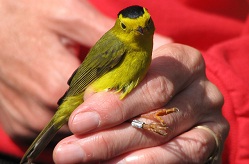
Bird ringing which involves the marking of individual birds is a rich source of scientific information providing vital data on a large spatial scale including migration patterns, demography, ecological processes and environmental changes. The ringing is performed by highly trained ornithologists and we are fortunate that many volunteers contribute to this activity.
Bird ringing for scientific purposes started in Denmark in 1889, when H. Chr. C. Mortensen released Starlings that were fitted with metal rings engraved with successive numbers and a return address. Since those pioneering times, bird ringing has quickly evolved into a standard research technique and is used in all parts of the world.
Scientific bird ringing is a research method based on the individual marking of birds. Any record of a ringed bird, either through recapture and subsequent release, or on the occasion of its final recovery as a dead bird, will tell us much about its life. This technique is one of the most effective methods to study the biology, ecology, behaviour, movement, breeding productivity and population demography of birds.
Tracking back the journeys of ringed birds allows us to identify their migration routes and staging areas, and this provides crucial information for the planning of integrated systems of protected areas for birds. Other information derived from recoveries and recaptures includes population parameters (e.g. survival estimates, lifetime and reproductive success), which are essential to determine the causes of changes in population sizes. Much of the data for this work is gathered by well-trained "professional amateurs" whose motivation is not profit but the simple privilege of working with birds for the ultimate purpose of conservation.
Other types of bird markers are fixed to bills, webbed feet, necks, tails and wings. Dyes are used on feathers and radio transmitters are used to track birds from day to day. Some markers are designed to wear off in time while others are meant to be permanent. The continued development of wireless and nano-technology promises to continue to change the possibilities for banding and marking wild birds.
Read more: The European Union for Bird Ringing (EURING) and AFRING - the African Bird Ringing Scheme
Modern Migratory Bird Science, Flyway Projects and Satellite Tracking
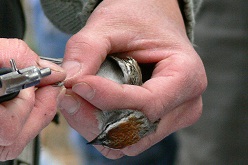
One method that has added a new dimension to avian research in recent years is satellite tracking. Tiny transmitters, usually carried in harnesses strapped to the birds' bodies, are linked to satellites. Each harness is custom-designed for each species and manually adjusted for each bird for maximum comfort of fit. The system enables researchers and conservationists to track individual birds continuously.
The results achieved by satellite tracking are ground-breaking. For the first time, the whole spatio-temporal pattern of successful migrations can be captured at a level of detail far exceeding that provided by ringing. Satellite tracking can also help discover unknown breeding, moulting or wintering areas of endangered species or the causes of massive losses. When combined with other devices, such as thermometers or miniature cameras, additional information of the birds' behaviour may be gathered. For example, recently the incredible journey the of the Arctic Tern (Sterna paradisaea) from pole to pole was recorded using satellite tracking.
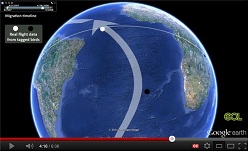
However, satellite tracking will not replace bird ringing in the near future. The reason for this is simple: transmitters are comparatively expensive, and sophisticated technical equipment is necessary. Furthermore, the technique is still limited to larger species, although this limitation might soon be overcome with technological progress in the field.
Video of the Arctic Tern's Pole to Pole Journey: EOL Arctic Tern Google Earth Tour
Flyway Projects and Initiatives
In recent years, several initiatives have been launched to better understand and protect the migration systems, or flyways of migratory birds around the globe. Scientific research and an improved understanding of migratory species, including birds, have led to a new approach in trying to sustain their habitats and their most vulnerable populations. Projects related to entire flyways have been launched in the past years. They aim at taking into consideration the numerous aspects of birds' migrations, including the relationship between birds and the people living in the areas they pass by or stop at.
The African-Eurasian Flyway and the Wings Over Wetlands Project
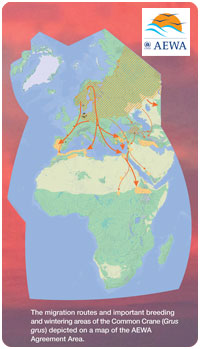
The Wings Over Wetlands (WOW) Project was the first international, flyway-scale wetland and waterbird conservation initiative ever to take place in the African-Eurasian region. The four year project (2006-2010) was a partnership among international conservation organizations and national governments, which aimed to improve and conserve healthy and viable populations of African-Eurasian migratory waterbirds.
The area covered by this flyway project included all 118 range states of the UNEP administered
African-Eurasian Migratory Waterbird Agreement (AEWA), a specialized treaty developed under the auspices of the Convention on Migratory Species (CMS) covering 255 waterbird species and a geographic range which spans across all of Africa, all of Europe, south-west Asia (including the Middle East and Central Asian States), Greenland and the Canadian Archipelago.
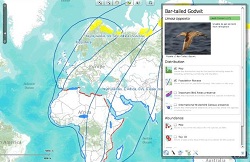 The Critical Site Network (CSN) Tool was developed within the WOW project and provides unprecedented access to information on over 300 migratory waterbird species, their migration routes and the key wetland sites these birds use in the African-Eurasian region. The CSN Tool supports conservation efforts of countries along the entire flyway. It provides decision-makers and conservation organizations with the improved access to data needed for timely and focused wetland and waterbird conservation.
The Critical Site Network (CSN) Tool was developed within the WOW project and provides unprecedented access to information on over 300 migratory waterbird species, their migration routes and the key wetland sites these birds use in the African-Eurasian region. The CSN Tool supports conservation efforts of countries along the entire flyway. It provides decision-makers and conservation organizations with the improved access to data needed for timely and focused wetland and waterbird conservation.
Learn more about The Wings Over Wetlands Project and The African-Eurasian Waterbird Agreement (AEWA)
To see where migratory birds in your area migrate to, use the The Critical Site Networking (CSN) Tool
Central Asian Flyway
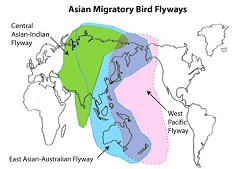
The Central Asian Flyway (CAF) is the shortest flyway in the world, but more than 300 species travel along it each year. It connects the Palaearctic with the Indian subcontinent.
The CMS Action Plan for the Central Asian Flyway provides the basis for the region's 30 Range States to take individual and coordinated region-wide activities to conserve waterbirds and their habitats. It contains provisions for species and habitat conservation, single species action plans and emergency measures. When adopted, it will be an umbrella for the creation of a CAF Site Network. Management of human activities, including hunting, eco-tourism, research, capacity building and implementation are covered under this new network of conservation partners.
Learn More about the Action Plan For Central Asian Flyway
Learn More about the Central Asian Flyway with the BirdLife Data Zone
East Asian-Australasian Flyway

The East Asia-Australasian Flyway is one of nine major flyways for migratory waterbirds around the globe. It extends from within the Arctic Circle in Russia and Alaska, southwards through East and South-east Asia, to Australia and New Zealand in the south, encompassing 22 countries. Migratory waterbirds share this flyway with 45 per cent of the world's human population.
The Flyway is home to over 50 million migratory waterbirds - including shorebirds, Anatidae (ducks, geese and swans) and cranes - from over 250 different populations, including 28 globally threatened species.
There are currently 700 sites recognized as internationally important to migratory waterbirds along the flyway, many of which are located adjacent to human settlement and vulnerable to pressures arising from rapid social and economic development. Without international cooperation to address these threats, many waterbird species will face extinction in the near future.
Learn More about the The East Asia-Australasian Flyway
The Western Hemisphere Migratory Species Initiative
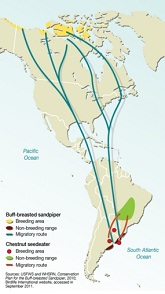
The countries of the Western Hemisphere share a common biological, cultural and economic heritage — their migratory birds, whales, bats, sea turtles, and butterflies. As these species' ranges span international boundaries, conservation stakeholders throughout the Americas need to work closely together to ensure the protection and conservation of their myriad habitats and migratory routes.
The mission of The Western Hemisphere Migratory Species Initiative (WHMSI) is to contribute significantly to the conservation of the migratory species of the Western Hemisphere. This is to be achieved by strengthening cooperation and communication among States, international initiatives and civil society, as well as by expanding constituencies, awareness and political support. All countries of the Western Hemisphere are parties to international conventions, treaties and accords as a result of which they are committed to the conservation of migratory species. WHMSI is an initiative to assist countries in fulfilling this commitment.
Learn More about the The Western Hemisphere Migratory Species Initiative


